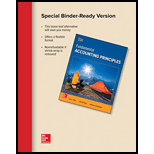
Concept explainers
Concept Introduction:
Cash payments for merchandise: The cash payments for merchandise are the cash payments made to the creditors of the business from whom the merchandise inventory has been purchased. The payment made to the creditors are based on the policies of the company. The company may decide to pay a portion of due in the month of purchase and a portion in the next month.
To compute:
Cash payments for January, February and March
Answer to Problem 27QS
Solution:
Cash payments for January = $ 28,320
Cash payments for February = $ 16,920
Cash payments for March = $ 19,240
| Torres Co. | |||
| Cash Disbursements for Merchandise (Budgeted) | |||
| For January, February and March | |||
| January | February | March | |
| Cash payment for current month's purchases | 6,320 | 7,440 | 8,080 |
| Cash payment for previous month's purchases | 22,000 | 9,480 | 11,160 |
| Total cash payments for merchandise | 28,320 | 16,920 | 19,240 |
Explanation of Solution
The cash payments for January, February and March are calculated as under -
1. Cash payments for January =
The cash payments for January are calculated as under –
Cash payment for December = $ 22,000
Cash payments for January Purchases –
Given,
• January purchases = $ 15,800
• Percentage of Merchandise purchases to be paid in January = 40 % ( 40 % to be paid in the month of purchase)
Cash payments for January Purchases = $ 6,320
Now, the cash payments for January is calculated as –
Given,
• Cash payments for December Purchases = $ 22,000
• Cash payments for January Purchases = $ 6,320
2. Cash payments for February =
The cash payments for February are calculated as under –
The cash payments for January purchases and February purchases are calculated as under –
Cash payments for January Purchases –
Given,
• August purchases = $ 15,800
• Percentage of Merchandise purchases to be paid in February = 60 % (60 % to be paid in the following month)
Cash payments for January Purchases = $ 9,480.
Cash payments for February Purchases –
Given,
• February purchases = $ 18,600
• Percentage of Merchandise purchases to be paid in February = 60 % ( 60 % to be paid in the month of purchase)
Cash payments for February Purchases = $ 7,440.
Now, the cash payments for February is calculated as –
Given,
• Cash payments for January Purchases = $ 9,480
• Cash payments for February Purchases = $ 7,440
3. Cash payments for March =
The cash payments for March are calculated as under –
The cash payments for February purchases and March purchases are calculated as under –
Cash payments for February Purchases –
Given,
• August purchases = $ 18,600
• Percentage of Merchandise purchases to be paid in March = 60 % ( 60 % to be paid in the following month)
Cash payments for February Purchases = $ 11,160.
Cash payments for March Purchases –
Given,
• March purchases = $ 20,200
• Percentage of Merchandise purchases to be paid in March = 40 % ( 40 % to be paid in the month of purchase)
Cash payments for March Purchases = $ 8,080.
Now, the cash payments for March is calculated as –
Given,
• Cash payments for August Purchases = $ 11,160
• Cash payments for September Purchases = $ 8,080
Thus, the schedule of cash payments for the Month of January, February and March has been prepared.
Want to see more full solutions like this?
Chapter 22 Solutions
Loose Leaf for Fundamental Accounting Principles
- Please provide the answer to this general accounting question using the right approach.arrow_forwardI am looking for the correct answer to this general accounting problem using valid accounting standards.arrow_forwardCan you solve this general accounting problem with appropriate steps and explanations?arrow_forward
- (1) prepare the december 31 entry for bramble corporation to record amortization of intangibles. the trademark has an estimated useful life of 4 years with a residual value of $3,520 [it is not $3,460]arrow_forwardPlease provide the solution to this general accounting question with accurate financial calculations.arrow_forwardI need help with this general accounting question using standard accounting techniques.arrow_forward

 AccountingAccountingISBN:9781337272094Author:WARREN, Carl S., Reeve, James M., Duchac, Jonathan E.Publisher:Cengage Learning,
AccountingAccountingISBN:9781337272094Author:WARREN, Carl S., Reeve, James M., Duchac, Jonathan E.Publisher:Cengage Learning, Accounting Information SystemsAccountingISBN:9781337619202Author:Hall, James A.Publisher:Cengage Learning,
Accounting Information SystemsAccountingISBN:9781337619202Author:Hall, James A.Publisher:Cengage Learning, Horngren's Cost Accounting: A Managerial Emphasis...AccountingISBN:9780134475585Author:Srikant M. Datar, Madhav V. RajanPublisher:PEARSON
Horngren's Cost Accounting: A Managerial Emphasis...AccountingISBN:9780134475585Author:Srikant M. Datar, Madhav V. RajanPublisher:PEARSON Intermediate AccountingAccountingISBN:9781259722660Author:J. David Spiceland, Mark W. Nelson, Wayne M ThomasPublisher:McGraw-Hill Education
Intermediate AccountingAccountingISBN:9781259722660Author:J. David Spiceland, Mark W. Nelson, Wayne M ThomasPublisher:McGraw-Hill Education Financial and Managerial AccountingAccountingISBN:9781259726705Author:John J Wild, Ken W. Shaw, Barbara Chiappetta Fundamental Accounting PrinciplesPublisher:McGraw-Hill Education
Financial and Managerial AccountingAccountingISBN:9781259726705Author:John J Wild, Ken W. Shaw, Barbara Chiappetta Fundamental Accounting PrinciplesPublisher:McGraw-Hill Education





